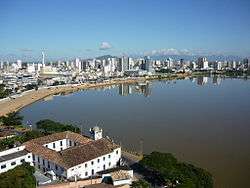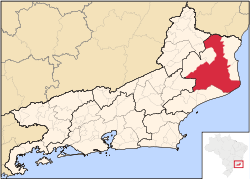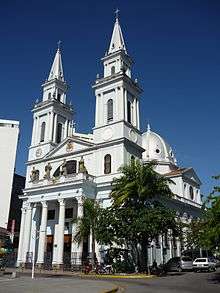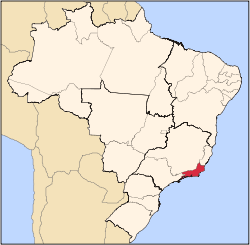Campos dos Goytacazes
Campos dos Goytacazes (Portuguese pronunciation: [ˈkɐ̃puʒ duʒ ɡojtaˈkaziʃ]) is a municipality located in the northern area of Rio de Janeiro State, Brazil, with a population of 503,424 inhabitants.
Campos dos Goytacazes | |
|---|---|
Municipality | |
| Município de Campos dos Goytacazes | |
 | |
 Flag  Coat of arms | |
| Nickname(s): "The Capital of Oil and Sugar" | |
 Location of Campos in the State of Rio de Janeiro | |
 Campos dos Goytacazes Location of Campos in the State of Rio de Janeiro | |
| Coordinates: 21°45′14″S 41°19′26″W | |
| Country | |
| Region | Southeast |
| State | |
| Founded | March 28, 1835 |
| Government | |
| • Mayor | Rafael Diniz (PPS) |
| Area | |
| • Total | 4,032 km2 (1,557 sq mi) |
| Elevation | 14 m (46 ft) |
| Population (2018) | |
| • Total | 503,424 |
| • Density | 120/km2 (320/sq mi) |
| [1] | |
| Time zone | UTC-3 |
| Postal Code | 28000-000 |
| Area code(s) | +55 22 |
| Website | Campos, Rio de Janeiro |
Location
Campos dos Goytacazes has an area of 4,032 km² (1,557 sq mi), which makes it the largest municipality in the state by area, and its elevation is 14 m. Its name comes from the geographical characteristic of the region, very flat with fields (campos in Portuguese) and from the Goytacazes Indians, which inhabited the region. Campos, as the city is usually known, is a macro region of the Northern Fluminense, and is a micro region of Campos dos Goytacazes. The city has a tropical climate.
The municipality contains part of the 21,444 hectares (52,990 acres) Desengano State Park, created in 1970.[2]
The city's distance to Rio de Janeiro city, which is the capital of the state, is 286 kilometres (178 mi). BR-101 is the access highway of the city of Campos. Regular air services are operated from its airport Bartolomeu Lysandro. It is the easternmost municipality in Rio de Janeiro.
History
Colonization of the area started in the 16th century, and the village of São Salvador de Campos de Goytacazes was founded on May 29, 1677. On March 28, 1835 the village was promoted to city status.
The Roman Catholic Diocese of Campos was the see of Bishop Antônio de Castro Mayer, nicknamed "The Lion of Campos", who was one of the bishops who opposed the Vatican II reforms and who teamed with Archbishop Marcel Lefebvre of Dakar to consecrate four independent bishops in Écône, Switzerland, in 1988. Nowadays there are in Campos two Roman Catholic jurisdictions: a Diocese, whose Bishop is Monsignor Roberto Gomes Guimarães and the Personal Apostolic Administration of Saint John Mary Vianney, whose Apostolic Administrator is Monsignor Fernando Areas Rifan.
Economy
City's economy is based on oil extraction. The GDP for the city was R$ 17,283,381. (2016).
The per capita income for the city was R$ 35,475. (2016).[3]
Crime
Campos dos Goytacazes recorded 233 homicides in 2018 for a murder rate of 46 homicides per 100,000 people for the year. This makes Campos dos Goytacazes the most violent city in the southern half of Brazil.[4][5]
Education

Educational institutions
- Universidade Estadual do Norte Fluminense;
- Universidade Cândido Mendes;
- Universidade Federal Rural do Rio de Janeiro;
- Faculdade de Medicina de Campos;
- Faculdade de Direito de Campos;
- Faculdade de Odontologia Campos;
- IF Fluminense (former CEFET Campos);
- Universidade Federal Fluminense;
- Universidade Salgado de Oliveira;
- Universidade Estácio de Sá;
- Faculdade Batista Fluminense;
- Ise-Censa;
- Unigranrio;
Demographics
| Population Growth of Campos dos Goytacazes | ||
|---|---|---|
| Year | Pop. | ±% |
| 1950 | 701,342 | — |
| 1960 | 630,054 | −10.2% |
| 1970 | 609,248 | −3.3% |
| 1980 | 564,329 | −7.4% |
| 1990 | 517,300 | −8.3% |
| 2000 | 436,008 | −15.7% |
| 2010 | 471,737 | +8.2% |
The population of Campos is 471,737, up from the 436,008 in 2000, but down from the 1990s, 1980s, 1970s, 1960s and 1950s. The city in the 1950s was the second largest of the state of Rio de Janeiro. The reasons behind these reductions are the "crash" that the economy of the town, based on oil, suffered in 1954, something similar that happened in Detroit with the auto industries. According to the 2010 census of IBGE (Brazilian institute of geography and statistics), whites represent 47.6% of population, brown or mulatos 36.8% and black of African 14.6%. Other races represent 1.0% of the population.

Sports
There are at least four football clubs in the city, namely Americano, Campos, Goytacaz and Rio Branco. The derby between Americano and Goytacaz is known as Goyta-cano.
References
- "2018 Populational Estimate" (PDF). Censo Populacional 2018. Instituto Brasileiro de Geografia e Estatística (IBGE).
- Upam Desengano flagra corte de madeira nativa em Santa Maria Madalena (in Portuguese), Inea: Instituto Estadual do Ambiente, 14 October 2015, archived from the original on 2017-01-13, retrieved 2017-01-12
- per capita income (PDF) (in Portuguese). Campos, Brazil: IBGE. 2005. ISBN 85-240-3919-1. Archived from the original (PDF) on 2008-10-02. Retrieved 2007-07-18.
- "List of cities by murder rate". seguridadjusticiaypaz.org.mx. Retrieved 22 August 2019.
- "50 of the most dangerous cities in the world". usatoday.com.
